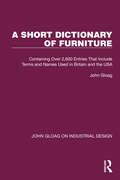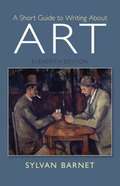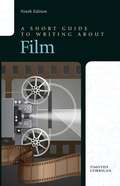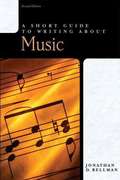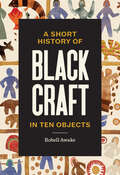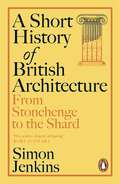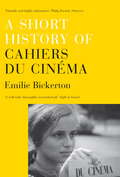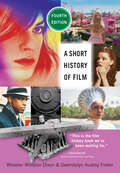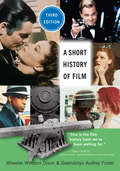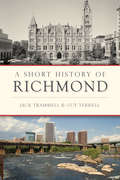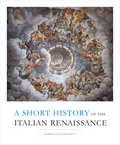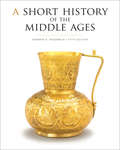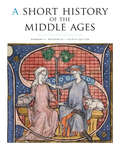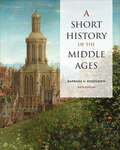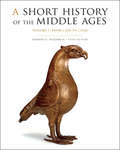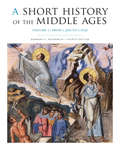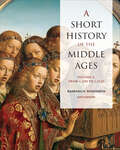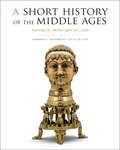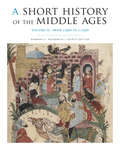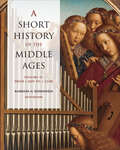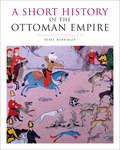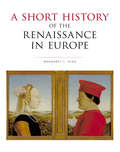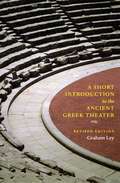- Table View
- List View
A Short Dictionary of Furniture: Containing Over 2,600 Entries That Include Terms and Names Used in Britain and the USA
by John GloagOriginally published in 1952 but enlarged and revised in 1969, this dictionary became a standard authoritative work of reference. It contains 2,612 entries and over 1,000 illustrations, reproduced from contemporary sources and from drawings by Ronald Escott, Marcelle Barton and Maureen Stafford. The work is divided into 6 sections: the first and second concern the description and design of furniture, the third contains the entries, the fourth gives a list of furniture makers in Britain and North America, section five records books and periodicals on furniture and design and the concluding section sets out in tabular form the periods with the materials used, and types of craftsmen employed from 1100 to 1950.
A Short Guide To Writing About Art (Eleventh Edition)
by Sylvan BarnetThe best-selling guide to writing about art, Sylvan Barnet's A Short Guide to Writing About Art guides students through every aspect of writing about art. Students are shown how to analyze pictures (drawings, paintings, photographs), sculptures and architecture, and are prepared with the tools they need to present their ideas through effective writing. Coverage of essential writing assignments includes formal analysis, comparison, research paper, review of an exhibition, and essay examination. New to the 11th edition is a chapter on "Virtual Exhibitions: Writing Text Panels and Other Materials. " MySearchLab is a part of the Barnet program. Research and writing tools, including access to academic journals, helps students master basic writing skills.
A Short Guide To Writing About Film
by Timothy CorriganThis best-selling text is a succinct guide to thinking critically and writing precisely about film. Both an introduction to film study and a practical writing guide, this brief text introduces students to major film theories as well as film terminology, enabling them to write more thoughtfully and critically. With numerous student and professional examples, this engaging and practical guide progresses from taking notes and writing first drafts to creating polished essays and comprehensive research projects. Moving from movie reviews to theoretical and critical essays, the text demonstrates how an analysis of a film can become more subtle and rigorous as part of a compositional process.
A Short Guide to Writing about Art
by Sylvan BarnetAddressed primarily to students in art history courses, the author has much to say on good writing, as he supports it with well-chosen samples. Emphasis on asking the right kind of question when viewing art.
A Short Guide to Writing about Music
by Jonathan D. BellmanWritten in a clear and conversational style, A Short Guide to Writing About Music examines a wide range of writing assignments for music courses at all levels of the undergraduate curriculum. Employing a variety of writing samples as a means to illustrate effective writing, this brief and inexpensive text teaches writers how to deftly research and write about music.
A Short History of Black Craft in Ten Objects
by Robell AwakeTen beautifully illustrated essays tell the stories of handcrafted objects and their makers, providing inspiration and insight into Black history and craftsmanship.Black artisans have long been central to American art and design, creating innovative and highly desired work against immense odds. Atlanta-based chairmaker and scholar Robell Awake explores the stories behind ten cornerstones of Black craft, including:The celebrated wooden chairs of Richard Poynor, an enslaved craftsman who began a dynasty of Tennessee chairmakers.The elegant wrought-iron gates of Philip Simmons, seen to this day throughout Charleston, South Carolina, whose work features motifs from the Low Country.The inventive assemblage art and yard shows of Joe Minter, James Hampton, Bessie Harvey, and others, who draw on African spiritual traditions to create large-scale improvisational art installations.From the enslaved potters of Old Edgefield, South Carolina, to Ann Lowe, the couture dressmaker who made Jacqueline Kennedy's wedding dress, to Gullah Geechee sweetgrass basket makers, to the celebrated quilters of Gee's Bend, A Short History of Black Craft in Ten Objects illuminates the work of generations of Black craftspeople, foregrounding their enduring contributions to American craft.BLACK CRAFT AND AMERICANA: Delving into the history of Black skilled artisans, estimated to have outnumbered white artisans five to one in the southern United States in the late 1800s, this unique art history book celebrates handcrafted objects that reflect the dynamic nature of Black culture.DYNAMIC ILLUSTRATED ESSAYS: Luminous color illustrations by artist Johnalynn Holland highlight beloved craft objects and their makers, creating a fascinating volume to study and treasure.ART HISTORY EXPERTISE: Author Robell Awake is a notable furniture maker, artisan, and educator whose work has been featured in the New York Times and in group shows at Verso Gallery in New York City and the Center for Craft in Asheville, NC. Dr. Tiffany Momon, who contributes an afterword, is the founder and co-director of the Black Craftspeople Digital Archive and a leading scholar of Black history and African American placemaking throughout the southeast.BEAUTIFUL GIFT BOOK: The gorgeous design is ideal for art collectors and craft enthusiasts, as a keepsake reminder of Black heritage, for Black History Month and beyond.Perfect for:Anyone interested in the intersection of Black art, craft, and historyDesigners and craftspeopleEducators and studentsCollectors and museum curatorsLovers of fine and artisanal design objects
A Short History of British Architecture: From Stonehenge to the Shard
by Simon Jenkins'Provocative, elegant, intriguing - Jenkins is a bold, imaginative writer, brilliant at challenging old assumptions and encouraging you to look at British architecture in a new light' Rory StewartThe story of Britain is revealed through its buildings, and yet the language of architecture is a mystery to all but a few. In this enlightening history, spanning castles and cathedrals to factories and railway stations, Jenkins translates the hidden narratives infused in the facades we walk past every day.Britain’s history has been formed by its politics, religion and society and these influences can be seen in the architectural styles that have shaped its landscape. From pre-Roman and the Middle Ages, to the Renaissance and the Industrial Revolution, Classical and Gothic styles surged and retreated from favour only to then be challenged by a new player: Modernism, a style that reflected the stunning technological advances of the second half of the twentieth century.In this narrative history, Simon Jenkins – the bestselling champion of our national heritage – introduces us to the singular, eccentric and sometimes rather ordinary characters who shaped Britain. Jenkins teaches readers to see the world anew, demystifying the elitist language of architecture so that we can all appreciate the buildings around us.
A Short History of Cahiers du Cinema
by Emilie BickertonCahiers du Cinéma was the single most influential project in the history of film. Founded in 1951, it was responsible for establishing film as the 'seventh art,' equal to literature, painting or music, and it revolutionized film-making and writing. Its contributors would put their words into action: the likes of Godard, Truffaut, Rivette, Rohmer were to become some of the greatest directors of the age, their films part of the internationally celebrated nouvelle vague.In this authoritative new history, Emilie Bickerton explores the evolution and impact of Cahiers du Cinéma, from its early years, to its late-sixties radicalization, its internationalization, and its response to the television age of the seventies and eighties. Showing how the story of Cahiers continues to resonate with critics, practitioners and the film-going public, A Short History of Cahiers du Cinéma is a testimony to the extraordinary legacy and archive these 'collected pages of a notebook' have provided for the world of cinema.From the Hardcover edition.
A Short History of Costume & Armour
by Francis M. Kelly Randolph SchwabeThis magnificent fashion history is a stylistic panorama that ranges from the Norman conquest to the early 19th century, focusing chiefly on armor, from the Crusades to the 17th century; clothing of the English upper classes, both sexes, 11th to 19th centuries; and accessories, including gloves, belts, corsets, shoes, and headgear. 342 black-and-white illustrations.
A Short History of Film, Fourth Edition
by Wheeler Winston Dixon Gwendolyn Audrey FosterA Choice Significant University Press Title for Undergraduates This updated and expanded edition of A Short History of Film provides an accessible overview of the major movements, directors, studios, and genres from the 1880s to the present. Succinct yet comprehensive, with more than 250 rare stills and illustrations, this edition provides new information on contemporary horror, comic book, and franchise films; issues surrounding women and minority filmmakers; the effects of the COVID-19 pandemic on movies worldwide; the shift from film to digital production; the rising use of artificial intelligence in cinema; and the impact of streaming on the industry. Beginning with the precursors of moving pictures, Wheeler Winston Dixon and Gwendolyn Audrey Foster lead a fast-paced tour through the invention of the kinetoscope, the introduction of sound and color between the two world wars, and ultimately the computer-generated imagery of the present day. They detail significant periods in world cinema, including the creation of early major industries in Europe, the dominance of the Hollywood studio system in the 1930s and 1940s, and the French New Wave of the 1960s. They also highlight independent efforts in developing nations and the corresponding more personal independent film movement that briefly flourished in the United States. Compact and easily readable, this is a vital history of international cinema is a one-stop resource for students, teachers, and general readers alike.
A Short History of Film, Third Edition
by Wheeler Winston Dixon Gwendolyn Audrey FosterWith more than 250 images, new information on international cinema—especially Polish, Chinese, Russian, Canadian, and Iranian filmmakers—an expanded section on African-American filmmakers, updated discussions of new works by major American directors, and a new section on the rise of comic book movies and computer generated special effects, this is the most up to date resource for film history courses in the twenty-first century.
A Short History of Richmond (Brief History)
by Jack Trammell Guy TerrellThe seven hills at the James River fall line that Captain John Smith first witnessed in 1607 became the site of a pivotal American city. Richmond was a birthplace of the American Revolution. It became the permanent capital of Virginia and served as the capital of the Confederacy during the Civil War. In the early twentieth century, industry expanded in the city as companies like DuPont and Philip Morris built factories. Cultural institutions expanded, with Richmond's first radio station and movie theater opening in the 1920s, before the Great Depression hit the city hard. The city rose from financial struggle to a highly industrialized center for manufacturing and vital transportation hub. Join authors Jack Trammell and Guy Terrell as they narrate the rich history of the River City.
A Short History of the Italian Renaissance
by Kenneth R. BartlettAward-winning lecturer Kenneth R. Bartlett applies his decades of experience teaching the Italian Renaissance to this beautifully illustrated overview. In his introductory Note to the Reader, Bartlett first explains why he chose Jacob Burckhardt's classic narrative to guide students through the complex history of the Renaissance and then provides his own contemporary interpretation of that narrative. Over seventy color illustrations, genealogies of important Renaissance families, eight maps, a list of popes, a timeline of events, a bibliography, and an index are included.
A Short History of the Middle Ages, Fifth Edition
by Barbara H. RosenweinIn this newest edition of her bestselling book, Barbara H. Rosenwein integrates the history of European, Byzantine, and Islamic medieval cultures—as well as their Eurasian connections—in a dynamic narrative. The text has been significantly updated to reflect growing interest in the Islamic world and Mediterranean region. Stunning plates featuring art and architecture weave together events, mentalities, and aesthetics. Medievalist Riccardo Cristiani authors a new feature on material culture that examines the intricacies of manuscript production and the lustrous glazes of Islamic ceramics. A fully revised map program offers user-friendly spot maps that clarify events right where they are discussed as well as dazzling topographical maps that reveal the very contours of the medieval world. Helpful genealogies, figures, architectural plans, and lists of key dates complement the text. All maps, genealogies, and figures are available on the History Matters website (www.utphistorymatters.com) for easy download. Students will find this site equally useful for its hundreds of study questions and their click-to-reveal answers.
A Short History of the Middle Ages, Fourth Edition
by Barbara H. RosenweinBarbara H. Rosenwein's bestselling survey text continues to stand out by integrating the history of three medieval civilizations (European, Byzantine, and Islamic) in a lively narrative that is complemented beautifully by 70 full-color plates, 46 maps, and 13 genealogies, many of them new to this edition. The fourth edition begins with an essay entitled "Why the Middle Ages Matter Today," and the book now covers East Central Europe in some depth. This edition includes three "Seeing the Middle Ages" features, each discussing a work of art in depth: An Ivory Diptych of Christ and the Virgin, Saint Luke, Gospel Book of Otto III; and A Shrine Madonna. The sections for further reading have been updated, and ancillary materials, including study questions, can be found on the History Matters website (www.utphistorymatters.com).
A Short History of the Middle Ages, Sixth Edition
by Barbara RosenweinIn this new edition of A Short History of the Middle Ages, Barbara H. Rosenwein offers a panoramic view of the medieval world from Iceland to China and from Sweden to West Africa. Yet the book never loses sight of the main contours of the period (c.300 to c.1500) or of the fate of the heirs of the Roman Empire. Its lively and informative narrative covers the major events, political and religious movements, men and women, saints and sinners, economic and cultural changes, ideals, fears, and fantasies of the period in Europe, Byzantium, and the Islamic world. A comprehensive new map program, updated for the global reach of this edition, offers a way to visualize the era’s enormous political, economic, and religious changes. Line drawings make clear archaeological finds and architectural structures All of the maps, genealogies, and figures in the book, as well as practice questions and suggested answers, are available at utphistorymatters.com,
A Short History of the Middle Ages, Volume I: From c.300 to c.1150, Fifth Edition
by Barbara H. RosenweinIn this newest edition of her bestselling book, Barbara H. Rosenwein integrates the history of European, Byzantine, and Islamic medieval cultures—as well as their Eurasian connections—in a dynamic narrative. This volume spans the period c.300 to c.1150. The text has been significantly updated to reflect growing interest in the Islamic world and Mediterranean region. Stunning plates featuring art and architecture weave together events, mentalities, and aesthetics. Medievalist Riccardo Cristiani authors a new feature on material culture that examines the intricacies of manuscript production and the lustrous glazes of Islamic ceramics. A fully revised map program offers user-friendly spot maps that clarify events right where they are discussed as well as dazzling topographical maps that reveal the very contours of the medieval world. Helpful genealogies, figures, architectural plans, and lists of key dates complement the text. All maps, genealogies, and figures are available on the History Matters website (www.utphistorymatters.com) for easy download. Students will find this site equally useful for its hundreds of study questions and their click-to-reveal answers.
A Short History of the Middle Ages, Volume I: From c.300 to c.1150, Fourth Edition
by Barbara H. RosenweinBarbara H. Rosenwein's bestselling survey text continues to stand out by integrating the history of three medieval civilizations (European, Byzantine, and Islamic) in a lively narrative that is complemented beautifully by full-color plates, maps, and genealogies. The fourth edition begins with an essay entitled "Why the Middle Ages Matter Today," and the book now covers East Central Europe in some depth. New plates have been added along with a new "Seeing the Middle Ages" feature. The sections for further reading have been updated, and ancillary materials, including study questions, can be found on the History Matters website (www.utphistorymatters.com).
A Short History of the Middle Ages, Volume I: From c.300 to c.1150, Sixth Edition
by Barbara RosenweinIn this new edition of A Short History of the Middle Ages, Barbara H. Rosenwein offers a panoramic view of the medieval world. Volume I ranges from northeastern North America to Kievan Rus’, while never losing sight of the main contours of the period c.300 to c.1150. The lively and informative narrative covers the major developments, political and religious movements, people, saints and sinners, economic and cultural changes, ideals, fears, and fantasies of the period in Europe, Byzantium, and the Islamic world. A comprehensive new map program, updated for the global reach of this edition, offers a way to visualize the era’s enormous political, economic, and religious changes. Line drawings make clear archaeological finds and architectural structures. All of the maps, genealogies, and figures in the book, as well as practice questions and suggested answers, are available at utphistorymatters.com.
A Short History of the Middle Ages, Volume II: From c.900 to c.1500, Fifth Edition
by Barbara H. RosenweinIn this newest edition of her bestselling book, Barbara H. Rosenwein integrates the history of European, Byzantine, and Islamic medieval cultures—as well as their Eurasian connections—in a dynamic narrative. This volume spans the period c.900 to c.1500. The text has been significantly updated to reflect growing interest in the Islamic world and Mediterranean region. Stunning plates featuring art and architecture weave together events, mentalities, and aesthetics. Medievalist Riccardo Cristiani authors a new feature on material culture that examines the intricacies of manuscript production and the lustrous glazes of Islamic ceramics. A fully revised map program offers user-friendly spot maps that clarify events right where they are discussed as well as dazzling topographical maps that reveal the very contours of the medieval world. Helpful genealogies, figures, architectural plans, and lists of key dates complement the text. All maps, genealogies, and figures are available on the History Matters website (www.utphistorymatters.com) for easy download. Students will find this site equally useful for its hundreds of study questions and their click-to-reveal answers.
A Short History of the Middle Ages, Volume II: From c.900 to c.1500, Fourth Edition
by Barbara H. RosenweinBarbara H. Rosenwein's bestselling survey text continues to stand out by integrating the history of three medieval civilizations (European, Byzantine, and Islamic) in a lively narrative that is complemented beautifully by full-color plates, maps, and genealogies. The fourth edition begins with an essay entitled "Why the Middle Ages Matter Today," and the book now covers East Central Europe in some depth. New plates and maps have been added along with a new "Seeing the Middle Ages" feature. The sections for further reading have been updated, and ancillary materials, including study questions, can be found on the History Matters website (www.utphistorymatters.com).
A Short History of the Middle Ages, Volume II: From c.900 to c.1500, Sixth Edition
by Barbara RosenweinIn this new edition of A Short History of the Middle Ages, Barbara H. Rosenwein offers a panoramic view of the medieval world. Volume II ranges from England to China and from West Africa to the Baltic, while never losing sight of the main contours of the period c.900 to c.1500. The lively and informative narrative covers the major developments, political and religious movements, people, saints and sinners, economic and cultural changes, ideals, fears, and fantasies of the period in Europe, Byzantium, and the Islamic world. A comprehensive new map program, updated for the global reach of this edition, offers a way to visualize the era’s enormous political, economic, and religious changes. Line drawings make clear archaeological finds and architectural structures. All of the maps, genealogies, and figures in the book, as well as practice questions and suggested answers, are available at utphistorymatters.com.
A Short History of the Ottoman Empire
by Renée WorringerThe Ottoman Empire was a formidable force involved in European politics and commerce, yet it has not received its due in popular narratives of early modern history. In this beautifully illustrated overview, Renée Worringer provides a clear and comprehensive account of the Empire’s six-hundred-year history. Uncovering the strategies behind the longevity of the Ottoman Empire, the author highlights the Empire’s pragmatism and flexibility in governing over vast territories and diverse peoples. In full color throughout, A Short History of the Ottoman Empire uses clear headings, themes, text boxes, primary source translations, and maps to assist students in understanding the Empire’s complex and lengthy history.
A Short History of the Renaissance in Europe
by Margaret L. KingWriting about the Renaissance can be a daunting task. Not only do scholars disagree on what the Renaissance is, but they also disagree on whether or not it even took place. Margaret L. King's richly illustrated social history of the Renaissance succeeds as a trusted resource, introducing readers to Europe between 1300–1700, as well as to the problems of cultural renewal. A Short History of the Renaissance in Europe includes a detailed discussion of Burckhardt as well as new content on European contact with the Islamic world. This new edition also provides improved coverage of the Protestant and Catholic Reformations. "Focus" features provide fascinating insights into the Renaissance era, and "Voices" sections introduce a wealth of primary sources. King's engaging narrative is enhanced by over 100 images, statistical tables, timelines, a glossary, and suggested readings.
A Short Introduction to the Ancient Greek Theater
by Graham LeyContemporary productions on stage and film, and the development of theater studies, continue to draw new audiences to ancient Greek drama. With observations on all aspects of performance, this volume fills their need for a clear, concise account of what is known about the original conditions of such productions in the age of Pericles. Reexamining the surviving plays of Aeschylus, Sophocles, Euripides, and Aristophanes, Graham Ley here discusses acting technique, scenery, the power and range of the chorus, the use of theatrical space, and parody in their plays. In addition to photos of scenes from Greek vases that document theatrical performance, this new edition includes notes on ancient mime and puppetry and how to read Greek playtexts as scripts, as well as an updated bibliography. An ideal companion to The Complete Greek Tragedies, also published by the University of Chicago Press, Ley’s work is a concise and informative introduction to one of the great periods of world drama. "Anyone faced with Athenian tragedy or comedy for the first time, in or out of the classroom, would do well to start with A Short Introduction to Ancient Greek Theater."—Didaskalia
